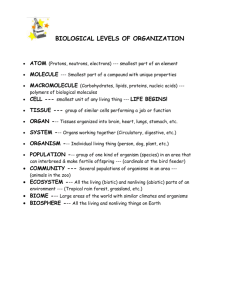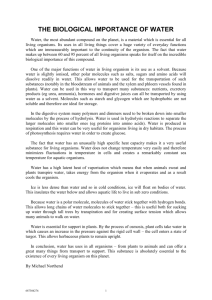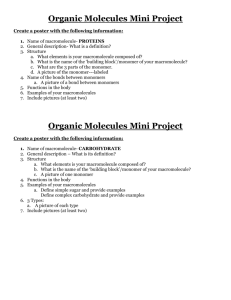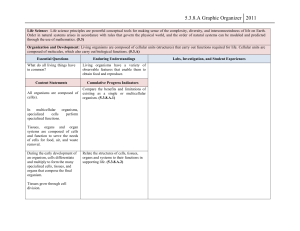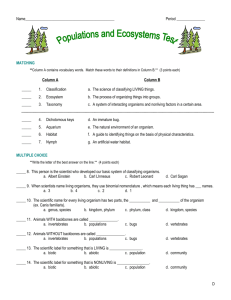Biochemistry Keystone Vocabulary
advertisement
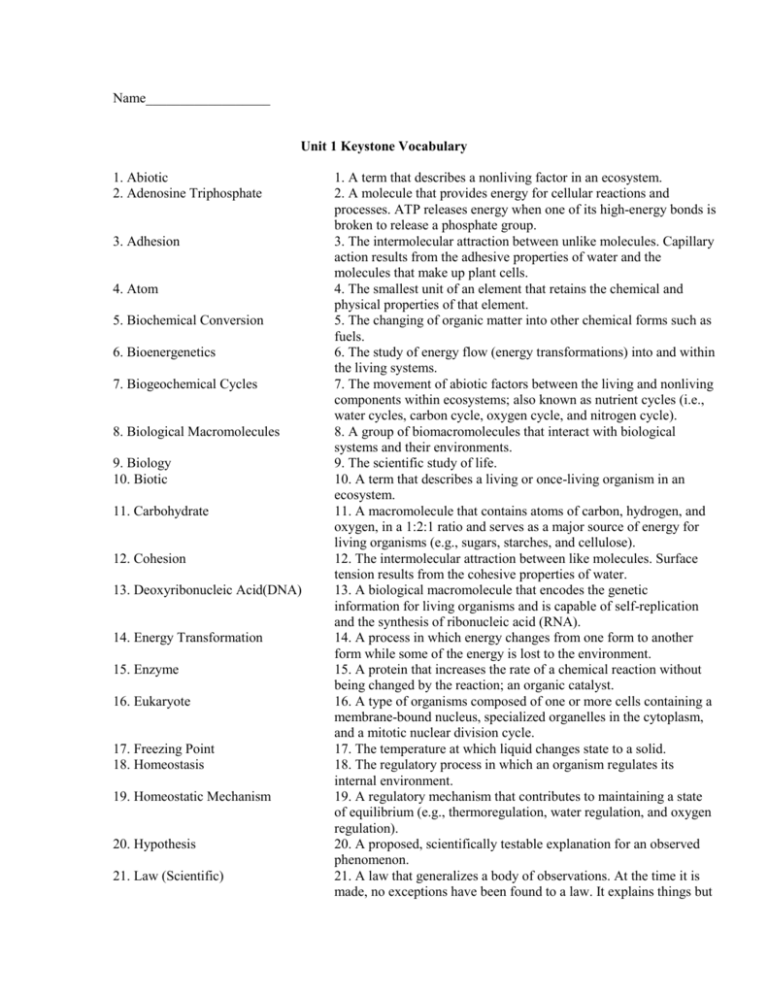
Name__________________ Unit 1 Keystone Vocabulary 1. Abiotic 2. Adenosine Triphosphate 3. Adhesion 4. Atom 5. Biochemical Conversion 6. Bioenergenetics 7. Biogeochemical Cycles 8. Biological Macromolecules 9. Biology 10. Biotic 11. Carbohydrate 12. Cohesion 13. Deoxyribonucleic Acid(DNA) 14. Energy Transformation 15. Enzyme 16. Eukaryote 17. Freezing Point 18. Homeostasis 19. Homeostatic Mechanism 20. Hypothesis 21. Law (Scientific) 1. A term that describes a nonliving factor in an ecosystem. 2. A molecule that provides energy for cellular reactions and processes. ATP releases energy when one of its high-energy bonds is broken to release a phosphate group. 3. The intermolecular attraction between unlike molecules. Capillary action results from the adhesive properties of water and the molecules that make up plant cells. 4. The smallest unit of an element that retains the chemical and physical properties of that element. 5. The changing of organic matter into other chemical forms such as fuels. 6. The study of energy flow (energy transformations) into and within the living systems. 7. The movement of abiotic factors between the living and nonliving components within ecosystems; also known as nutrient cycles (i.e., water cycles, carbon cycle, oxygen cycle, and nitrogen cycle). 8. A group of biomacromolecules that interact with biological systems and their environments. 9. The scientific study of life. 10. A term that describes a living or once-living organism in an ecosystem. 11. A macromolecule that contains atoms of carbon, hydrogen, and oxygen, in a 1:2:1 ratio and serves as a major source of energy for living organisms (e.g., sugars, starches, and cellulose). 12. The intermolecular attraction between like molecules. Surface tension results from the cohesive properties of water. 13. A biological macromolecule that encodes the genetic information for living organisms and is capable of self-replication and the synthesis of ribonucleic acid (RNA). 14. A process in which energy changes from one form to another form while some of the energy is lost to the environment. 15. A protein that increases the rate of a chemical reaction without being changed by the reaction; an organic catalyst. 16. A type of organisms composed of one or more cells containing a membrane-bound nucleus, specialized organelles in the cytoplasm, and a mitotic nuclear division cycle. 17. The temperature at which liquid changes state to a solid. 18. The regulatory process in which an organism regulates its internal environment. 19. A regulatory mechanism that contributes to maintaining a state of equilibrium (e.g., thermoregulation, water regulation, and oxygen regulation). 20. A proposed, scientifically testable explanation for an observed phenomenon. 21. A law that generalizes a body of observations. At the time it is made, no exceptions have been found to a law. It explains things but 22. Lipids 23. Macromolecule 24. Mechanism (Scientific) 25. Molecule 26. Monomer 27. Organ 28. Organ System 29. Organelle 30. Organic Molecule 31. pH 32. Population 33. Principle (Scientific) 34. Prokaryote 35. Protein 36. Science 37. Specific Heat 38. System 39. Temperature 40. Theory (Scientific) does not describe them; serves as the basis of scientific principles. 22. A group of organic compounds composed mostly of carbon and hydrogen including a proportionately smaller amount of oxygen; are insoluble in water, serve as a source of stored energy, and are a component of cell membranes. 23. A polymer with a high molecular mass. Within organisms there are four main groups: carbohydrates, lipids, proteins, and nucleic acids. 24. The combination of components and processes that serve a common function. 25. The smallest particle of a substance that retains the chemical and physical properties of the substance and is composed of two or more atoms held together by chemical forces. 26. A molecule of any compound that can react with other molecules of the same or different compound to form a polymer. Each biological macromolecule has characteristic monomers. 27. An anatomical unit composed of tissues serving a common function. 28. An anatomical system composed of a group of organs that work together to perform a specific function or task. 29. A subunit within a cell that has a specialized function. 30. A molecule containing carbon that is a part of or produced by living systems. 31. The measure of acidity or alkalinity (basicity) of an aqueous solution scaling from 1 (highly acidic) to 14 (highly alkaline) with a midpoint of 7 (neutral). 32. A group of individuals of the same species living in a specific geographical area and reproducing. 33. A concept based on scientific laws and axioms (rules assumed to be present, true, and valid) where general agreement is present. 34. An organism that uses a primary energy source to conduct photosynthesis or chemosynthesis. 35. A macromolecule that contains the principal components of organisms: carbon, hydrogen, oxygen, and nitrogen; performs a variety of structural and regulatory functions for cells. 36. A body of evidence-based knowledge gained through observation and experimentation related to the natural world and technology. 37. The measure of the heat energy required to increase the temperature of a unit quantity of a substance by a certain temperature interval 38. A set of interacting or interdependent components, real or abstract, that form an integrated whole. An open system is able to interact with its environment. A closed system is isolated from its environment. 39. A measure of the average kinetic energy (energy of motion) of particles in a sample of matter. This physical property can determine the rate and extent to which chemical reactions can occur within living systems. It is commonly measures in degrees Celsius (°C) or Fahrenheit (°F). 40. An explanation of observable phenomena based on available empirical data and guided by a system of logic that includes scientific laws; provides a system of assumptions, accepted principles, and rules of procedure devised to analyze, predict, or otherwise explain the nature or behavior of a specific set of phenomena.

